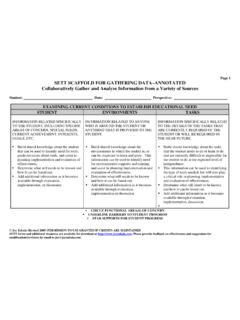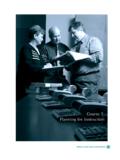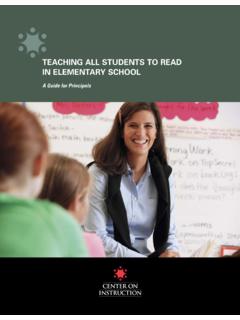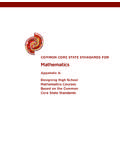Transcription of The SETT Framework: Straight from the Horse’s Mouth
1 Joy Zabala (2010) Contact by email - or 1 1 The SETT Framework: Straight from the Horse s Mouth Joy Zabala, , ATP Director of Technical Assistance CAST and the AIM Center SETT 2 PDF of presentation available for download at SETT 3 Big Ideas in this Session The SETT Framework: Myths and Realities The SETT Framework and Assistive Technology Decision-making The SETT Framework and Universal Design for Learning (UDL) The SETT Framework and Accessible Instructional Materials SETT 4 The SETT Framework 5 The Vision Students with diverse abilities, needs, and experiences in various educational environments use a plethora of tools: 1) to accomplish tasks that lead to educational achievement and, 2) as a means to demonstrate achievement!
2 6 MYTH 1 SETT is an school-based assistive technology assessment protocol. Joy Zabala (2010) Contact by email - or 2 7 REALITY The SETT Framework ..a flexible tool that makes concerns-identification and solution-seeking processes accessible to all and is useful in all phases decision-making and service delivery SETT 8 The Student / Self The person who is the central focus of the process. The person for whom everyone involved in any part of the program is an advocate. 9 Environments The customary environments in which the person is (or can be) expected to live, learn and grow 10 Tasks The specific things that the person needs or wants to be able to do to reach expectations 11 The Tools Everything that is needed by the person and others for the person to accomplish the tasks in the places where they need to be done so that progress is achieved 12 MYTH 2 It is important that the SETT Framework be explored in student, then environments, then tasks and finally, tools.
3 Joy Zabala (2010) Contact by email - or 3 13 REALITY It is almost impossible to talk about one without mentioning the others. SETT 14 The SETT Framework 15 Decision-Making Sequence Develop shared understanding of the Student, learning Environments, and expected Tasks BEFORE Tools are considered or selected 16 MYTH 3 The SETT Framework is primarily for selecting AT devices 17 REALITY SETT 18 MYTH 4 SETT is a process. Joy Zabala (2010) Contact by email - or 4 19 REALITY The SETT Framework requires a process, but does not dictate a particular process SETT 20 8-Step Decision-Making Process 1.
4 Identify areas of concern 2. Gather information on aspects related to concerns 3. Analyze information 4. Generate prioritize and potential solutions 21 8-Step Decision-Making Process 5. Develop a plan 6. Work the plan and collect data on effectiveness 7. Revise the plan as indicated by data 8. Document 22 MYTH 4 It takes a lot of time to use the SETT Framework. 23 REALITY It only takes as long as it needs to take to understand and address the needs of the student SETT 24 REALITY If the student s needs are complex it may take a good bit of time. If not, it could be only moments. SETT Joy Zabala (2010) Contact by email - or 5 25 MYTH 5 It is possible to complete a SETT Framework.
5 26 The SETT Framework supports continuing effort. Assessment and intervention form a continuous, dynamic process Guiding Principles Arkansas Tech Act Project REALITY SETT 27 The SETT Framework as a Place to Start ! What do I know, from my perspective? ! What do WE know, collectively? ! What do we still need to know and how can we find out? ! What outcomes do we expect? ! What system of supports and services (if any) is needed for this student to progress? 28 Revisiting the SETT Framework? When? Why? By Whom? Give me six good reasons! Edna M. Smiley My Mom 29 Six Good Reasons to Revisit the SETT Framework 1.
6 What was known may have changed. 2. New people may be involved. 3. New questions and/or information may have emerged 4. More specifics may be available. 5. Implementation plans need to be student-centered AND environmentally friendly 6. Other-imposed plans are rarely successful 30 Remember Two Things! A SETT Framework is ON-GOING ! Re-SETTing is not starting It is a matter of keeping decision-guiding information accurate, up to date,and clearly inclusive of the shared knowledge of all involved ! Implementation Tip: Save As! Joy Zabala (2010) Contact by email - or 6 31 The SETT Framework and Assistive Technology 32 Assistive Technology Includes a broad range of possible devices and services Enhances capabilities and the lowers barriers to achievement Is related to function, rather than to a specific disability category May be applicable to all disability groups and in all phases of education, rehabilitation, and life Must be person-centered, task-focused and environmentally useful to be effective 33 Student (Self) What is the functional area(s) of concern?
7 What does the student need to be able to do that is difficult or impossible to do independently at this time? Special needs (related to area of concern) Strengths and abilities (related to area of concern) Present levels of achievement Expectations (student s) Evaluation information 34 Environments Supports Barriers Arrangement (instructional, physical) Support (available to both the student and the staff) Materials and Equipment (commonly used by others in the environments) Access Issues (technological, physical, instructional) Attitudes and Expectations (staff, family, other)
8 Conditions within customary environments 35 Tasks The specific things that the student needs to be able to do to reach expectations and make progress The functional things that are a part of being actively involved in learning environments Communication Instruction Participation Productivity Environmental Control 36 Tools Whatever is needed by the student and others for the student to do the tasks in the environments in order to meet expectations ABILITIES GOALS TOOLS Joy Zabala (2010) Contact by email - or 7 37 Tools for the Student /Self Accommodations Modifications Technology Diversified support or instructional strategies Accessible Materials Supports and Services Training Documentation Etc.
9 Whatever is needed to enable the student to do (or learn to do) the tasks that lead to high levels of participation and achievement 38 Tools for Others Support for Family and Staff Training and support on: Decision-making Diversified strategies Accommodations and Modification s Device integration and operation Environmental management Service delivery Etc. Whatever is needed by others for the person to do the tasks in the environments in order to meet expectations 39 The SETT Framework and Universal Design for Learning 40 UDL looks to make the learning environment as flexible and accommodating as possible.
10 41 Universal Design for Learning Is a framework for ensuring access, participation and progress in the general education curriculum Assumes and plans for diverse student strengths and needs Places emphasis on using digital technology and other strategies and materials to support diverse learners Is not limited to high tech environments 42 Purpose of UDL UDL selects and uses goals, methods, assessment and materials in a way that minimizes barriers and maximizes flexibility so that curricula fully support every student's access, participation, and progress in essential facets of learning.








